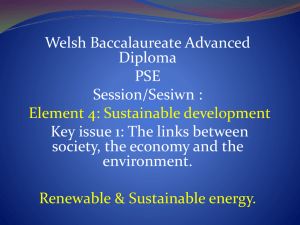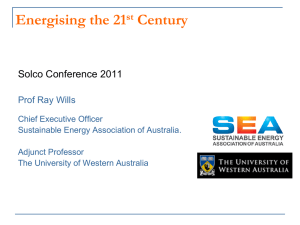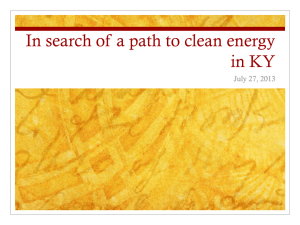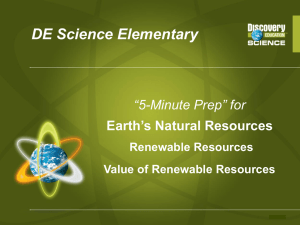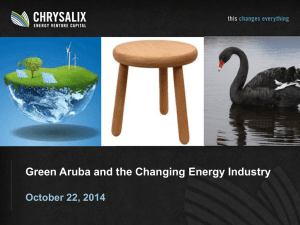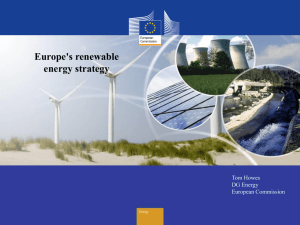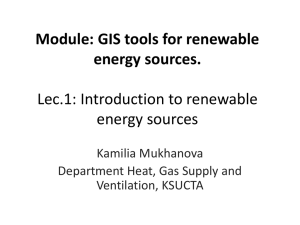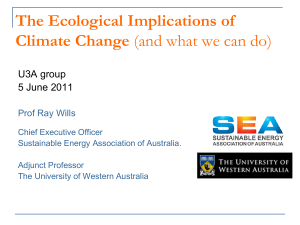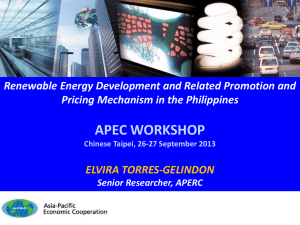Community Engagement - Core Presentation
advertisement
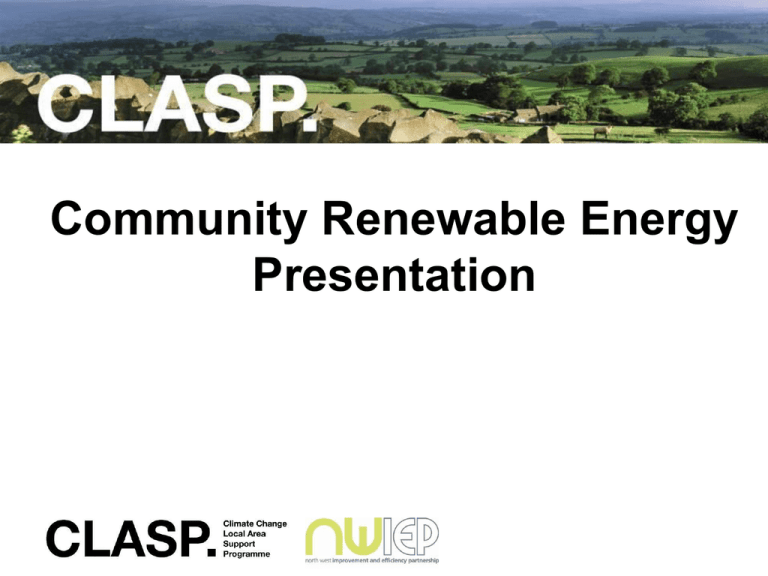
Community Renewable Energy Presentation For information only. Remove this slide when delivering presentation Introduction to the presentation • WHAT IS IT? to deliver a presentation on how to develop a renewable energy scheme, along with other useful tools. • WHO IS IT FOR? community groups, local authorities and other people interested in developing a community scale renewable energy project. • WHY DO WE NEED IT? to create better informed communities who understand the different types of renewable energy technologies, their impacts and the common misconceptions around them. With this we are hoping to encourage more community groups to bring forward renewable energy schemes. • WHO PAID FOR IT? £1m North West Climate Change Skills Fund funded by the UK Government to support planning for carbon reduction and climate change in the North West, managed by the Climate Change Local Area Support Programme (CLASP). Visit www.clasp-nw.info for more information. For information only. Remove this slide when delivering presentation How to use this Toolkit This toolkit covers eight renewable energy technologies at community scale and it has been designed so that users who are not familiar with the technologies can still deliver a 1 hour (approximately) presentation to community groups based on a series of materials. Follow the following steps in order to use the toolkit: Remove slide 3 (current slide) Go through slides 1 to 8, using the information contained in the notes at the bottom of the slides. Remove slide 9 and insert the slides for the technology(ies) that your community is considering to install, for example ‘2. PV slides’ and ‘3.Hydro slides’. Go through the contents on the technology slides inserted. To support this, you will need the information contained in the appropriate factsheets on the CLASP website, for example ‘Factsheet 2: Solar Photovoltaics’ and ‘Factsheet 3: Hydro Power’. The notes at the bottom of the slides will guide you through the content and appropriate pages on factsheets. Use the factsheets relevant to your subregion for more local information. The last slide contains case studies. Follow the links on the notes page to the documents which you can print or have on the screen. Once you have covered the different technologies, carry on with the main toolkit slides (you should now be on slides 10 to 14) and follow the instructions and links contained in the notes at the bottom. Slide 13 contains further sources of information which are available on the CLASP website: Checklist and Literature Library. You can print those resources or show them on the screen. How is energy ‘normally’ produced? Electricity Heat What are the alternatives – renewable energy? Fossil fuel Renewable fuel • Renewable energy is energy which comes from natural resources such as wind, sunlight, rain, tides or geothermal heat. • These sources are considered renewable as they are naturally replenished • They offer an alternative to fossil fuels such as oil, gas or coal. For a free demonstration on explaining renewable energy with moving images view: http://www.jsheducation.com/4P16._Renewable_Energy_I.swf What’s in it for a community? Community benefits from renewable energy projects: • Protection against rising fossil fuel prices • Make money for your community • More local jobs • Reduce your community carbon emissions • Improve community well-being The wider context • EU Energy Directive • UK Renewable Energy Strategy • North West potential What are the options? ELECTRICITY HEAT Wind turbines Heat pumps Solar PV Hydro power COMBINED HEAT AND POWER Biomass District Heating Solar thermal For information only. Remove this slide when delivering presentation Insert here slides for technology(ies) being considered How to access funding and finance? Different sources of finance: • Shares • Grants • Loans • Other (raising equity, entering an Energy Service Company (ESCO) contract, etc… Energy Saving Trust funding database http://origin-akamai.est.org.uk/cafe/Green-Communities/Funding-Advice/Green-Communities-Funding-Database Funding guidance video http://www.planlocal.org.uk/videos/videopages/project-finance.html How to get planning permission? Stages of an application for planning permission: • • • • • • Find out who your Local Authority or Local Authorities are? Fill in an application (Local Authority or Planning Portal) Local Authority checks, advertise and consult Local Authority considers national guidelines and local development plans, before making a recommendation to planning committee. Planning committee refuses or grants permission, maybe with conditions Local Authority responds within 8 weeks of application (could be longer if the application is complex or encounters opposition) Who owns the project? Different options for owning and benefiting from a community renewable energy projects: • • • • • Owned by members of the community Owned by a not-for-profit organisation Owned by the Local Authority Owned by a commercial company or managing agent Creating an Energy Service Company (ESCO) What are the next steps? • • • Carry out an initial assessment Move into the detail of the project. Check out the rest of the ‘Community Renewable Energy Toolkit’: 1. 2. Community Renewable Energy Projects Checklist: a step to step guide with links to sources of information and assistance. Literature Library: explore any of the topics covered in more detail. Both the checklist and the literature library can be found on the CLASP website. Visit www.clasp-nw.info for more information “The wise man does at once what the fool does finally.” Baltasar Gracian (1601-1658) “Twenty years from now you will be more disappointed by the things that you didn't do than by the ones you did do” Mark Twain (1835-1910) “Good actions give strength to ourselves and inspire good actions in others” Plato (427 – 347 BC) Picture references, in order of appearance: • Sellafield Dome, Greenpeace www.greenpeace.org.uk • National Grid, Pradesh Today http://www.pradeshtoday.com/new_details.php?news=24+hour+electricity+supply • Home appliances, Lowes Appliances online http://lowesappliances.net/ • Natural gas diagram, Clean Energy Cryostar http://www.cryostar.com/web/geopressure.php • Gas flame, Lovelin Gas Boiler Service http://www.lovekin.co.uk/gas-boiler-service-alton-gu34.html • Radiator, UK Heat.com http://www.ukheat.com/ • Sun, Bahiehk,com http://bahiehk.com/2011/02/15/ • Geothermal Energy, Alternative Energy Resources. net http://www.alternative-energy-resources.net/advantages-ofgeothermal-energy.html • Wave, Wikimedia Commons http://commons.wikimedia.org/wiki/File:Ocean_surface_wave.jpg • 10. Coal, Science Image http://www.scienceimage.csiro.au/mediarelease/mr08-38.html • Natural gas, Oil Gas Information http://oilgasinformation.com/natural-gas-uses • Petroleum, The Encyclopaedia of Earth http://www.eoearth.org/articles/view/158383/ • Installer, Mark Group http://www.markgroup.co.uk/news/kingspan-solar-accreditation/ • Community stove, Baltidome blog http://baltidome.wordpress.com/2009/08/ • PV in school, Ashden Awards http://www.ashdenawards.org/media/uk_photos/2008 • Community wind turbine, Ecodefy http://www.ecodyfi.org.uk/prnewturbine.htm • Wind turbine, solar PV and hydro power systems, Energy Saving Trust • Micro CHP, Ecobuild http://www.ecobuild.co.uk/exhibitor-list/profile/1867/calor-gas-ltd.html • Air source heat pump, Low Carbon Economy http://www.lowcarboneconomy.com/profile/ecovision_ltd/_products_and_services/air_source_heat_pumps/6252 • Biomass, district heating and solar thermal systems, Energy Saving Trust • Planning approval, NI Planning Permission.com http://www.niplanningpermission.co.uk/ • Green communities meeting and green communities, Energy Saving Trust • Community, New Charter Housing Trust http://www.newcharter.co.uk/
